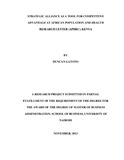| dc.description.abstract | In the recent past, strategic alliance has increasingly been used as an important tool for gaining competitive advantage in the market place. This has been much so within the commercial sector but the concept has equally received much attention and use within the nonprofit sector. Therefore this case study set to look at how strategic alliance has been used as a tool for competitive advantage at APHRC and the challenges faced by APHRC in managing the strategic alliances. The study adopted a case study design so as to undertake an in-depth and comprehensive inquiry. The study interviewed ten middle-to-senior level managers. Content analysis was used to analyze the data and generate relevant results. The key findings were that APHRC is engaged in strategic alliances that are contractual in nature. These alliances have taken the form of consortia, working groups, memoranda of associations, collaborations and networks and have helped APHRC in taking a forefront position within the nonprofits and hence helped it gain competitive advantage. Some of the benefits to APHRC include increased visibility of its programs to its various stakeholders, widened geographical reach in operations, economies of scale, expansion into new programmatic grounds, learning from partners’ experiences, shared risks and costs. It has helped to increase funding levels and improved buy-in of its findings. The study therefore concluded that APHRC is involved in strategic alliances as a way to gain sustainable competitive advantage. The alliances have contributed to positioning APHRC at the forefront of generations of ideas that continue to shape the future of research in it’s the priority areas of population, health and education, in research capacity building and in being a voice that informs policy. This has helped APHRC to remain relevant in the market in the midst of the ever changing environmental conditions. In the future, it will be important to look at how all parties to an alliance benefit competitively, what other factors besides alliances bring about competitive advantage and the application of a different research design other than a case study to the study. | en |

